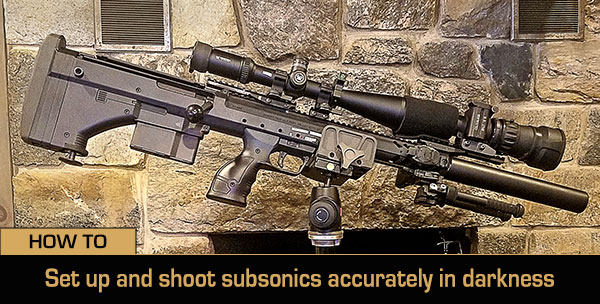 Nearly every night I browse the internet in search of tips and advice from experts to better my shooting game. For me, it’s the only way to satisfy my urge to shoot when I don’t have the time to actually shoot. I lie in bed and read and read until I pass out from exhaustion.
Nearly every night I browse the internet in search of tips and advice from experts to better my shooting game. For me, it’s the only way to satisfy my urge to shoot when I don’t have the time to actually shoot. I lie in bed and read and read until I pass out from exhaustion.
I just found Jonathan’s article which discusses hunting hogs with suppressed subsonic Maker REX bullets and it was no accident. I know I found this article only hours after Google did because today I was celebrating the arrival of my 180gr Maker REX bullets and bumped into his hog story while ‘dreaming’ I had time to shoot with these new arrivals! I love reading about this sport and now it’s time to contribute.
I have a bolt action Dessert Tech SRS Covert .308 with a 16 inch barrel and an AWC Thor suppressor. It’s a heavy 25 pound system which sits on a Manfrotto tripod, magnesium ball head and hog saddle. The crank on this tripod is an awesome feature as there is never a reason to adjust the legs. It’s heavy, which my research says is the best type of tripod. Precision rifle blog or Snipershide did a great research report on tripods. I don’t know why more guys don’t shoot with this tripod but I think it’s the best. Carbon fiber and lightweight tripods, the report suggests, are not the answer. They all performed poorly. I went for the best tripod rated to hold my heavy rig. But it’s not for the faint of heart; the Manfrotto tripod, magnesium ball head and hog saddle set me back $1,300 or so.
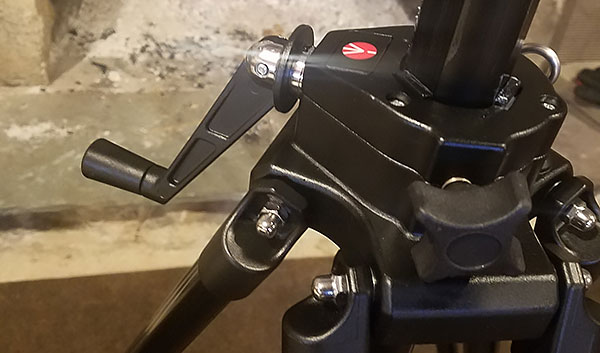 I originally set up the rig with an Trijicon EO Hunter MK II thermal device (sold under the IR Defense brand before Trijicon bought it). If you haven’t used this thermal you might not believe the image quality. It’s unbelievable and I strongly recommend it.
I originally set up the rig with an Trijicon EO Hunter MK II thermal device (sold under the IR Defense brand before Trijicon bought it). If you haven’t used this thermal you might not believe the image quality. It’s unbelievable and I strongly recommend it.
The MK II thermal is an amazing tool for supersonics and it might even be the perfect device for subsonics if you have a target at 100 yards. However, a subsonic .308 drops about 11 inches from 100 to 150 yards, which is a holdover well beyond my pay grade if I’m using the MKII TDR (Thermal Dot Reticle). It has a 1000:1 ratio instead of 100:1 where each dot gives you 36 inches of elevation at 100 yards instead of 3.6 inches. Here’s a snippet from my MK II owner’s manual.
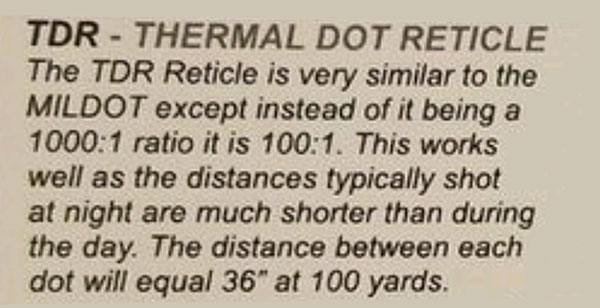 You’ll go bananas trying to achieve precision with thermal and subsonics even with a first focal reticle like the one on the MK II. I learned this quickly and the only way the deal with this trajectory issue was to sight-in and save a 150 yard reticle and switch between the two, but fumbling between reticles A and B with electronics while on a nighttime hunt seems a bit clumsy to me. I spoke to a good friend about my dilemma. He convinced me to use my MK II as a monocular and to shoot with clip-on night vision. It doesn’t sound sexy, I’ll admit, but he told me, “Military snipers use PVS 30s”. Alright then.
You’ll go bananas trying to achieve precision with thermal and subsonics even with a first focal reticle like the one on the MK II. I learned this quickly and the only way the deal with this trajectory issue was to sight-in and save a 150 yard reticle and switch between the two, but fumbling between reticles A and B with electronics while on a nighttime hunt seems a bit clumsy to me. I spoke to a good friend about my dilemma. He convinced me to use my MK II as a monocular and to shoot with clip-on night vision. It doesn’t sound sexy, I’ll admit, but he told me, “Military snipers use PVS 30s”. Alright then.
The sticker price knocked me off my chair… I didn’t have $12,000 for this experiment. Back to relentless research while lying in bed. I searched for a good deal on an AN-PVS 30. I found the guys at Ready Made Resources and they had refurbished Knights Armament units for less than 1/2 price and it came with a 1 year KAC warranty. The guys at Ready Made Resources are awesome. These units were military trade-ins which sweetened the deal as I love my country’s military. I had enough AMEX points to do this! This was my chance.
No doubt, thermal acquisition is beyond anything night vision can do, but if you want to place a subsonic bullet on a postage stamp at distances past 100 yards, a PVS 30 is the ticket.
My rig is now equipped with a PVS 30 by Knights Armament and it sits in front of an IOR Valdada RECON, which is a 4-28 power scope with a 40mm main tube and a generous field of view. I spent a considerable amount of time researching scopes. The IOR RECON is the only scope that offered both wide 4 power and strong 28 power magnification and perfect tracking. The scope even has a secondary zero so you can have a zero for subs and supers on your turret. This model scope is perfect for my application. The glass is amazing and it married well to my PVS 30.
I probably shot 8 – 10 boxes of subsonic BECK ammo through my barrel before I found myself capable of sub MOA accuracy and I did it with the AMAX in a prone position with a cold bore. I achieved repeatability and amazing results once I focused on a cold bore. Attached below is a picture of 3 shot group (my best group ever) with the 168gr subsonic AMAX by Beck Ammunition.
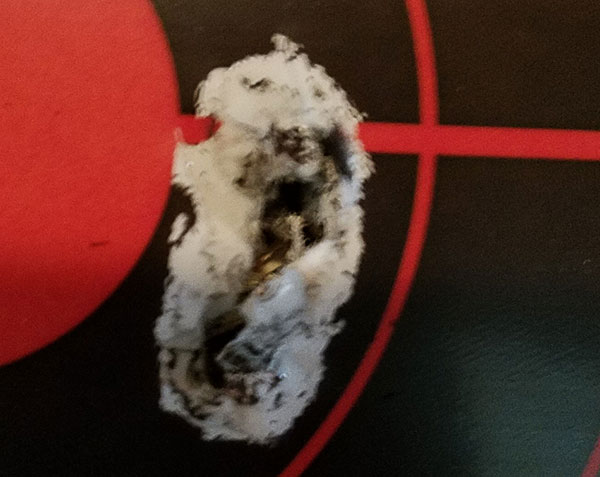 My barrel sends these rounds down range at about 1025fps and even though most guys say only the first round is considered cold, subs run cooler and I consider all three of these of these shots to be cold. I can’t keep tight groups if I shoot like a cowboy. My rig needs to cool off to do precision work. Hopefully this lesson will save some shooter out there similar frustrations. This was especially true with flat points.
My barrel sends these rounds down range at about 1025fps and even though most guys say only the first round is considered cold, subs run cooler and I consider all three of these of these shots to be cold. I can’t keep tight groups if I shoot like a cowboy. My rig needs to cool off to do precision work. Hopefully this lesson will save some shooter out there similar frustrations. This was especially true with flat points.
But even after learning so much I still had some issues to sort out. I would still occasionally send rounds low left or I would get unexplained fliers. Then one day during one of my online relentless research sessions, I googled ” shifting point of impact” and I stumbled upon the topic of “canting errors”. I proceeded to learn about canting errors and the solutions – ACDs, or Anti Canting Devices.
High trajectory and excessive scope height exacerbate canting errors. Viola!
It all made sense now. Here I am shooting with a 3 inch scope height and subs which obviously have excessive trajectory, but I never paid much attention to cant error. The fix for this might be a bubble level for most shooters but how would that help me correct cant under the cover of night? I searched “electronic ACD’s” which brought me to a SHOT Show 2017 video highlighting a new product by Long Range Arms called “Send it”, an electronic anti canting device with LED lights. This device was the icing on my cake, a game changer. Clearly visible day or night, this ACD’s green light lets you know when to “send it”. In these pictures, the red line is my plumb bob to which my ACD is calibrated. Notice when canted just a bit, the lights turn blue. If canted the other way, it signals red. In the field it’s easy to read, especially if you shoot with both eyes open as I do. Just cant in the direction of your lights to correct the error.
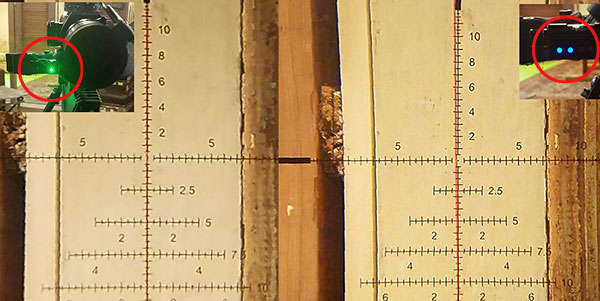 Before concluding my story, let me suggest the following article. It will wrap your head around canting errors. If you are shooting subsonics, you really should read it. Read it 3 or 4 times or until you fully grasp the illustrations. Some guys say canting is only an important factor for long range which might be true for supersonics, but it is crucial for shooting subsonics even at short distances due to the projectile’s trajectory. Seriously, it’s the best ever canting effect article (no offense to SHWAT here!).
Before concluding my story, let me suggest the following article. It will wrap your head around canting errors. If you are shooting subsonics, you really should read it. Read it 3 or 4 times or until you fully grasp the illustrations. Some guys say canting is only an important factor for long range which might be true for supersonics, but it is crucial for shooting subsonics even at short distances due to the projectile’s trajectory. Seriously, it’s the best ever canting effect article (no offense to SHWAT here!).
I don’t think it was an accident how perfectly I placed this bullet after learning all my lessons. I am thankful for every author and for every individual who has helped me figure out the subsonic puzzle. Hopefully my contribution here helps you!
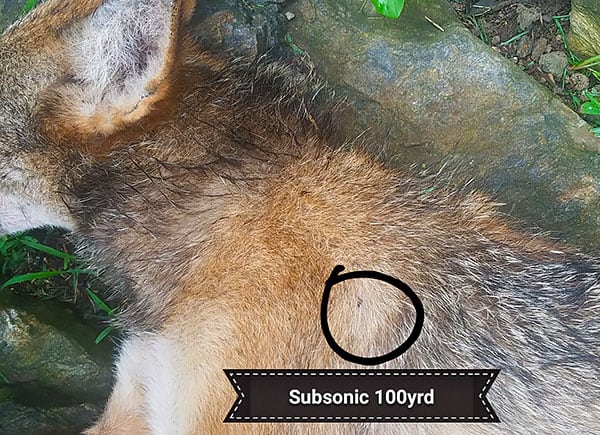
About the guest author, RogerThatOut
RogerThatOut lives in CT but travels when a good hunting opportunity pops up. A shooter and hunter, he particularly enjoys predator hunting. Nuisance permits open other hunting doors. Between hunts, he shoots for fun on paper and steel.
Have a story to share? Tell us!

